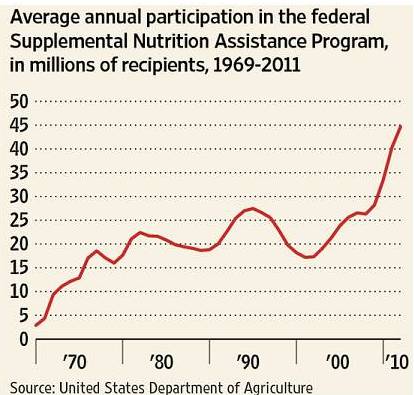A Quincy, Mass., grocery store owner was arrested last week on criminal charges of engaging in a scheme with customers to trade federal food stamp benefits for cash. This incident, one of many, adds more fuel to Paul Ryan's plan to reform the federal program, which has skyrocketed over the past decade from barely $18 billion in 2001 to more than $80 billion this year.
Ryan, the Republican House Budget Committee chairman, contends the food stamp program is rife with waste and fraud, and he unveiled a budget last month that would dramatically overhaul the program. Last week, the House Agriculture Committee made the first big down payment on Ryan’s plan of reducing the deficit and averting deep cuts in defense by approving $33 billion in food stamp savings over the next 10 years that would knock two million people off the rolls and likely reduce benefits for 44 million others.
Government spending on food stamps and other “social safety net” programs for the poor, elderly and disabled generates considerable election year heat, especially in times of economic distress and soaring deficits. Former Republican House Speaker Newt Gingrich dubbed President Obama the “food stamp president” because the number of recipients has increased by 14.2 million during the past three years. Yet even more people were added to the program during the administration of Republican President George W. Bush.
Few doubt the vital importance of the food stamp program in helping millions of Americans to make ends meet and put food on the table. The challenge today for the White House and a sorely divided Congress is to balance reform, the needs of the working poor and others who have been unable to find a job in the worst recession of modern times. Yet lawmakers and policy experts appear to be so deeply entrenched in their views that it is hard to see how they will find common ground.
The House Agriculture Committee vote was largely symbolic because nobody thinks Senate Democrats would go along with such a draconian cut and Obama is opposed to sharp reductions in food stamps and other nutrition programs for the poor. Yet as Congress gears up this week to rewrite major farm subsidy and nutritional support legislation, the burgeoning food stamp program looms as a likely target for long term spending cuts.
For one thing, The Congressional Budget Office reported that 45 million -- one out of seven -- people in 2011 received Supplemental Nutrition Assistance Program (SNAP) benefits, a 70% increase from 2007.
This is due in large part to the adverse impact of the recession, a temporary increase in SNAP benefits under the Recovery Act, and a change in how people qualify for the program. While critics complain about the program’s mushrooming cost and vulnerability to abuse and rip-offs, others credit SNAP with helping to counteract the spread of poverty during the Great Recession, putting food on the table of low-income families and encouraging the poor to find jobs.
“There is no denying that SNAP provides important support for many Americans. That’s why it’s important that we ensure the integrity of this program,” House Agriculture Committee Chairman Frank Lucas, R-Okla., said last week in defending the huge proposed cuts. “The committee demonstrated that we are committed to doing our part to reduce the debt and provide nutrition assistance for American families most in need.”

However, Rep. Collin Peterson of Minnesota, the ranking Democrat on the committee, responded, "Taking a meat ax to nutrition programs that feed millions of hard-working families in an effort to avoid defense cuts is not a serious way to achieve deficit reduction."
A TIME TO SOW, A TIME TO REAP
One reason Democrats are dismissing last week’s House Agriculture Committee action is that lawmakers exclusively targeted SNAP for deep cuts while leaving farm subsidy and insurance programs unscathed. Typically, Congress lumps farm programs and food stamps together in authorizing and appropriating funds, and advocates for the agriculture industry and the poor frequently make tradeoffs to protect their respective constituencies.
This time, however, the farm states and agricultural interests prevailed over the urban and rural poor. “No other program under the agriculture committee’s jurisdiction would face any cut under the proposal, despite frequent calls for reform of the nation’s farm subsidies – 74 percent of which go to the largest, most profitable farms,” the left-leaning Center on Budget and Policy Priorities said in a statement last week.
“If you gave me a choice to put a bulls-eye on the most egregious example of waste, fraud and abuse in the federal government, it would be the farm programs,” said Scott Lilly, a former Democratic chief of staff of the House Appropriations Committee. “But these guys get elected to Congress in order to serve on the Agriculture Committee because they were elected to protect those programs, so they will cut anything before they cut those subsidies that go largely to millionaire producers.”
The Senate Agriculture Committee on Wednesday will begin work on a new major farm and nutrition bill that would cut about $23 billion in spending over the coming decade to help reduce the deficit. But unlike the House approach, the Senate would achieve most of the savings through reductions in agriculture assistance, while cutting the food stamp program by only $4 billion.
The Obama administration has proposed reducing the deficit by $32 billion over 10 years by eliminating direct farm payments, decreasing subsidies to crop insurance companies, and better targeting conservation funding, but with no cuts in food and nutrition programs.





